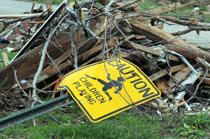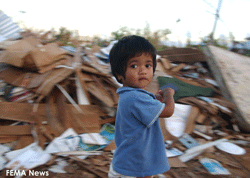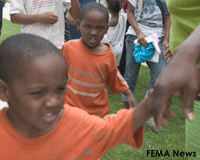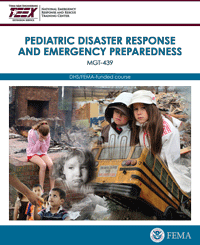Children in Crisis: TEEX course addresses pediatric disaster planning & response
 A tornado flattens an elementary school in Oklahoma. A gunman opens fire in a school in Connecticut.
A tornado flattens an elementary school in Oklahoma. A gunman opens fire in a school in Connecticut.
Children are often at the center of a disaster or crisis, but response communities are often ill-equipped to deal with the special needs of this vulnerable population.
The Texas A&M Engineering Extension Service (TEEX) is committed to addressing some of those needs by providing specialized training for emergency managers and planners, physicians, hospital and healthcare officials, as well as EMS, fire, police and public health personnel.
In the past two years, more than 2,000 healthcare and emergency response personnel in 32 states have learned more about this special population by attending a two-day course in
“Pediatric Disaster Response and Emergency Preparedness.”
 Topics include specific considerations for children during a disaster, such as mass sheltering, pediatric triage, reunification planning and pediatric decontamination, said Senior Training Specialist John Rinard with TEEX Emergency Services Training Institute.
Topics include specific considerations for children during a disaster, such as mass sheltering, pediatric triage, reunification planning and pediatric decontamination, said Senior Training Specialist John Rinard with TEEX Emergency Services Training Institute.
It is not a clinical or technical course, but a management course to make community stakeholders aware of the unique needs of children and to help them prepare and plan for managing a disaster that impacts large groups of children, he said. A multi-state coalition has developed standards for pediatric planning, and many emergency planners are recognizing there are gaps that need to be addressed, he added.
During the aftermath of Hurricane Katrina, thousands of children were separated from their families. In 2010, a report by the National Commission on Children and Disasters called for the development of a national strategy for children in disasters to ensure children are protected before, during and after an emergency. A brand new policy statement from the American Academy of Pediatrics (AAP) also calls for a greater focus on children’s needs in disasters. The course builds on these recommendations.
 “Children make up one-fourth of the population and they have unique physical, mental, behavioral, developmental, therapeutic, communication and social needs,” Rinard added. “The goal of this course is to increase awareness about their needs and to ensure communities are better informed, and as a result, can better prepare for the child in crisis. I send the class home with questions and a To Do’ list.”
“Children make up one-fourth of the population and they have unique physical, mental, behavioral, developmental, therapeutic, communication and social needs,” Rinard added. “The goal of this course is to increase awareness about their needs and to ensure communities are better informed, and as a result, can better prepare for the child in crisis. I send the class home with questions and a To Do’ list.”
“The MGT-439 pediatrics response course is well-researched with the latest standards and policies for pediatric care during emergencies, and draws heavily from lessons learned from many actual incidents,” said recent participant Ashley Miller, Emergency Preparedness Educator with the DelValle Institute for Emergency Preparedness. “The instructors are experts in the field, and were successful in creating a collaborative environment for participants to share experiences from their own work. In essence, there is much to take away from this two-day course.”
The course is funded by the DHS/FEMA Homeland Security National Training Program Cooperative Agreement through the sponsorship of the DHS/FEMA National Training and Education Division, and offered nationwide at no cost to qualified participants.
 “We are the only provider in the DHS realm that is addressing pediatrics and pediatric preparedness from the planning perspective,” Rinard said. “We recognize the importance of this, and we’re in it for the long haul. We want to provide the resources to facilitate the safety of children in communities throughout the U.S.”
“We are the only provider in the DHS realm that is addressing pediatrics and pediatric preparedness from the planning perspective,” Rinard said. “We recognize the importance of this, and we’re in it for the long haul. We want to provide the resources to facilitate the safety of children in communities throughout the U.S.”
The course uses lectures, small group exercises, case studies, simulations and a tabletop exercise. Best practices and procedures are incorporated from the American Academy of Pediatrics, the American College of Emergency Physicians, the National Commission on Children and Disasters and the National Response Framework, among others.
Due to the surge in interest and over 400 positive responses from state training offices, TEEX plans to develop additional pediatric disaster preparedness courses that address other aspects of managing the special needs of children in crisis.
While the program has made inroads in the healthcare community, Rinard says he would like to provide more training for those in emergency management and public safety.
“Hospitals and fire stations, for example, don’t feel they will serve as a shelter for families and children,” he said, “but they need to recognize that because they will likely have electric power, water and food during a crisis, people will be coming, so they need to be prepared.”
MEDIA CONTACTS:
Brian Blake, TEEX Communications Director
[email protected]
PH: 979-458-6837, Cell: 979-324-8995
Will Welch
[email protected]
PH: 979-458-6979, Cell: 979-220-2840
